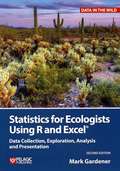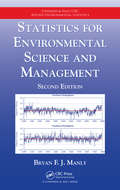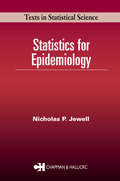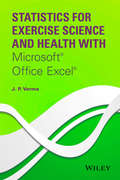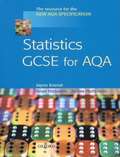- Table View
- List View
Statistics for Data Scientists: An Introduction to Probability, Statistics, and Data Analysis (Undergraduate Topics in Computer Science)
by Maurits Kaptein Edwin van den HeuvelThis book provides an undergraduate introduction to analysing data for data science, computer science, and quantitative social science students. It uniquely combines a hands-on approach to data analysis – supported by numerous real data examples and reusable [R] code – with a rigorous treatment of probability and statistical principles. Where contemporary undergraduate textbooks in probability theory or statistics often miss applications and an introductory treatment of modern methods (bootstrapping, Bayes, etc.), and where applied data analysis books often miss a rigorous theoretical treatment, this book provides an accessible but thorough introduction into data analysis, using statistical methods combining the two viewpoints. The book further focuses on methods for dealing with large data-sets and streaming-data and hence provides a single-course introduction of statistical methods for data science.
Statistics For Dummies (For Dummies)
by Deborah J. RumseyStatistics For Dummies, 2nd Edition (9781119293521) was previously published as Statistics For Dummies, 2nd Edition (9780470911082). While this version features a new Dummies cover and design, the content is the same as the prior release and should not be considered a new or updated product. The fun and easy way to get down to business with statistics Stymied by statistics? No fear? this friendly guide offers clear, practical explanations of statistical ideas, techniques, formulas, and calculations, with lots of examples that show you how these concepts apply to your everyday life. Statistics For Dummies shows you how to interpret and critique graphs and charts, determine the odds with probability, guesstimate with confidence using confidence intervals, set up and carry out a hypothesis test, compute statistical formulas, and more. Tracks to a typical first semester statistics course Updated examples resonate with today's students Explanations mirror teaching methods and classroom protocol Packed with practical advice and real-world problems, Statistics For Dummies gives you everything you need to analyze and interpret data for improved classroom or on-the-job performance.
Statistics For Dummies
by Deborah J. RumseyThe fun and easy way to get down to business with statistics Stymied by statistics? No fear? this friendly guide offers clear, practical explanations of statistical ideas, techniques, formulas, and calculations, with lots of examples that show you how these concepts apply to your everyday life. Statistics For Dummies shows you how to interpret and critique graphs and charts, determine the odds with probability, guesstimate with confidence using confidence intervals, set up and carry out a hypothesis test, compute statistical formulas, and more. Tracks to a typical first semester statistics course Updated examples resonate with today's students Explanations mirror teaching methods and classroom protocol Packed with practical advice and real-world problems, Statistics For Dummies gives you everything you need to analyze and interpret data for improved classroom or on-the-job performance.
Statistics for Earth and Environmental Scientists
by John H. Schuenemeyer Lawrence J. DrewA comprehensive treatment of statistical applications for solving real-world environmental problems A host of complex problems face today's earth science community, such as evaluating the supply of remaining non-renewable energy resources, assessing the impact of people on the environment, understanding climate change, and managing the use of water. Proper collection and analysis of data using statistical techniques contributes significantly toward the solution of these problems. Statistics for Earth and Environmental Scientists presents important statistical concepts through data analytic tools and shows readers how to apply them to real-world problems. The authors present several different statistical approaches to the environmental sciences, including Bayesian and nonparametric methodologies. The book begins with an introduction to types of data, evaluation of data, modeling and estimation, random variation, and sampling—all of which are explored through case studies that use real data from earth science applications. Subsequent chapters focus on principles of modeling and the key methods and techniques for analyzing scientific data, including: Interval estimation and Methods for analyzinghypothesis testing of means time series data Spatial statistics Multivariate analysis Discrete distributions Experimental design Most statistical models are introduced by concept and application, given as equations, and then accompanied by heuristic justification rather than a formal proof. Data analysis, model building, and statistical inference are stressed throughout, and readers are encouraged to collect their own data to incorporate into the exercises at the end of each chapter. Most data sets, graphs, and analyses are computed using R, but can be worked with using any statistical computing software. A related website features additional data sets, answers to selected exercises, and R code for the book's examples. Statistics for Earth and Environmental Scientists is an excellent book for courses on quantitative methods in geology, geography, natural resources, and environmental sciences at the upper-undergraduate and graduate levels. It is also a valuable reference for earth scientists, geologists, hydrologists, and environmental statisticians who collect and analyze data in their everyday work.
Statistics for Earth and Environmental Scientists
by John H. Schuenemeyer Lawrence J. DrewA comprehensive treatment of statistical applications for solving real-world environmental problems A host of complex problems face today's earth science community, such as evaluating the supply of remaining non-renewable energy resources, assessing the impact of people on the environment, understanding climate change, and managing the use of water. Proper collection and analysis of data using statistical techniques contributes significantly toward the solution of these problems. Statistics for Earth and Environmental Scientists presents important statistical concepts through data analytic tools and shows readers how to apply them to real-world problems. The authors present several different statistical approaches to the environmental sciences, including Bayesian and nonparametric methodologies. The book begins with an introduction to types of data, evaluation of data, modeling and estimation, random variation, and sampling—all of which are explored through case studies that use real data from earth science applications. Subsequent chapters focus on principles of modeling and the key methods and techniques for analyzing scientific data, including: Interval estimation and Methods for analyzinghypothesis testing of means time series data Spatial statistics Multivariate analysis Discrete distributions Experimental design Most statistical models are introduced by concept and application, given as equations, and then accompanied by heuristic justification rather than a formal proof. Data analysis, model building, and statistical inference are stressed throughout, and readers are encouraged to collect their own data to incorporate into the exercises at the end of each chapter. Most data sets, graphs, and analyses are computed using R, but can be worked with using any statistical computing software. A related website features additional data sets, answers to selected exercises, and R code for the book's examples. Statistics for Earth and Environmental Scientists is an excellent book for courses on quantitative methods in geology, geography, natural resources, and environmental sciences at the upper-undergraduate and graduate levels. It is also a valuable reference for earth scientists, geologists, hydrologists, and environmental statisticians who collect and analyze data in their everyday work.
Statistics for Ecologists Using R and Excel:Data collection, exploration, analysis and presentation (PDF)
by Mark GardenerThis is a book about the scientific process and how you apply it to data in ecology. You will learn how to plan for data collection, how to assemble data, how to analyze data and finally how to present the results. The book uses Microsoft Excel and the powerful Open Source R program to carry out data handling as well as producing graphs. Statistical approaches covered include: data exploration; tests for difference - t-test and U-test; correlation - Spearman's rank test and Pearson product-moment; association including Chi-squared tests and goodness of fit; multivariate testing using analysis of variance (ANOVA) and Kruskal-Wallis test; and multiple regression. Key skills taught in this book include: how to plan ecological projects; how to record and assemble your data; how to use R and Excel for data analysis and graphs; how to carry out a wide range of statistical analyses including analysis of variance and regression; how to create professional looking graphs; and how to present your results. New in this edition: a completely revised chapter on graphics including graph types and their uses, Excel Chart Tools, R graphics commands and producing different chart types in Excel and in R; an expanded range of support material online, including; example data, exercises and additional notes & explanations; a new chapter on basic community statistics, biodiversity and similarity; chapter summaries and end-of-chapter exercises.
Statistics for Economics, Accounting and Business Studies
by Michael Barrow C. Rashaad ShababA reader-friendly introduction to the exciting world of statistics for the analysts, business leaders and policymakers of tomorrow. "Barrow and Shabab's Statistics for Economics, Accounting and Business Studies textbook has an excellent mix of application, intuition and statistical theory that is suitable for students with and without prior knowledge in statistics." Dr Robert Riegler, Senior Lecturer in Economics, Aston University Statistics for Economics, Accounting, and Business Studies,8th edition by Michael Barrow and C. Rashaad Shabab, is a user-friendly introduction to the subject, aimed at students studying economics, accountancy, finance, and business. This comprehensive text applies a wide variety of statistical tools and techniques to real-world situations, with numerous examples and exercises integrated throughout to help you build up your knowledge and skills. Easy to follow and without requiring any prior knowledge of Statistics, this book will guide you through the essential principles of the field and provide a thorough analysis of statistical concepts and methods. Key features in this new edition include: A new chapter on Data Visualisation, reflecting the growing importance of this topic Application of statistics to issues of contemporary interest, such as the impact of global events like Covid-19, development economics, tourism, education and working hours A greater focus on data science and big data, with supporting online material including data sets, software and code (Python and R) to analyse the data, as well as Excel versions, included for those who prefer Plenty of exercises and problems to test your understanding of the subject and measure your progress "An accessible, real-world and practical book. What really struck me about is that the book goes beyond a 'cook-book' approach (first, we do this, then we do that...). There is depth of analysis of the key methodological concepts." Dr Nektarios Tzempelikos, Associate Professor of Marketing, Anglia Ruskin University "This has long been my recommended text for business school undergraduates studying economics, finance or accounting. The focus on applications over theory makes it suitable for students with and without A level maths. It is rightly popular with my students." Professor David Paton, Nottingham University Business School
Statistics for Economics and Business
by David BowersThis comprehensive statistics text for students of economics and business has a modern and attractive approach that integrates computer applications using standard software packages, including SPSS and Minitab. These are used to complement and illustrate the development of the theoretical material. The text draws examples from economics, business and the social sciences and will be suitable for use internationally on courses throughout the world.
Statistics for Empowerment and Social Engagement: Teaching Civic Statistics to Develop Informed Citizens
by Jim Ridgway“This book is a remarkable achievement” Gerd GigerenzerThis book offers practical approaches to working in a new field of knowledge - Civic Statistics - which sets out to engage with, and overcome well documented and long-standing problems in teaching quantitative skills. The book includes 23 peer-reviewed chapters, written in coordination by an international group of experts from ten countries. The book aims to support and enhance the work of teachers and lecturers working both at the high school and tertiary (university) levels. It is designed to promote and improve the critical understanding of quantitative evidence relevant to burning social issues – such as epidemics, climate change, poverty, migration, natural disasters, inequality, employment, and racism.Effective citizen engagement with social issues requires active participation and a broad understanding of data and statistics about societal issues. However, many statistics curricula are not designed to teach relevant skills nor to improve learners' statistical literacy. Evidence about social issues is provided to the public via print and digital media, official statistics offices, and other information channels, and a great deal of data is accessible both as aggregated summaries and as individual records. Chapters illustrate the approaches needed to teach and promote the knowledge, skills, dispositions, and enabling processes associated with critical understanding of Civic Statistics presented in many forms. These include: statistical analysis of authentic multivariate data; use of dynamic data visualisations; deconstructing texts about the social and economic well-being of societies and communities. Chapters discuss: the development of curricula and educational resources; use of emerging technologies and visualizations; preparation of teachers and teaching approaches; sources for relevant datasets and rich texts about Civic Statistics; ideas regarding future research, assessment, collaborations between different stakeholders; and other systemic issues.
Statistics for Engineering and the Sciences
by William M. Mendenhall Terry L. SincichPrepare Your Students for Statistical Work in the Real WorldStatistics for Engineering and the Sciences, Sixth Edition is designed for a two-semester introductory course on statistics for students majoring in engineering or any of the physical sciences. This popular text continues to teach students the basic concepts of data description and statist
Statistics for Engineering and the Sciences
by William M. Mendenhall Terry L. SincichPrepare Your Students for Statistical Work in the Real WorldStatistics for Engineering and the Sciences, Sixth Edition is designed for a two-semester introductory course on statistics for students majoring in engineering or any of the physical sciences. This popular text continues to teach students the basic concepts of data description and statist
Statistics for Engineering and the Sciences Student Solutions Manual
by William M. Mendenhall Terry L. Sincich Nancy S. BoudreauA companion to Mendenhall and Sincich’s Statistics for Engineering and the Sciences, Sixth Edition, this student resource offers full solutions to all of the odd-numbered exercises.
Statistics for Engineering and the Sciences Student Solutions Manual
by William M. Mendenhall Terry L. Sincich Nancy S. BoudreauA companion to Mendenhall and Sincich’s Statistics for Engineering and the Sciences, Sixth Edition, this student resource offers full solutions to all of the odd-numbered exercises.
Statistics for Engineers: An Introduction
by Jim MorrisonThis practical text is an essential source of information for those wanting to know how to deal with the variability that exists in every engineering situation. Using typical engineering data, it presents the basic statistical methods that are relevant, in simple numerical terms. In addition, statistical terminology is translated into basic English. In the past, a lack of communication between engineers and statisticians, coupled with poor practical skills in quality management and statistical engineering, was damaging to products and to the economy. The disastrous consequence of setting tight tolerances without regard to the statistical aspect of process data is demonstrated. This book offers a solution, bridging the gap between statistical science and engineering technology to ensure that the engineers of today are better equipped to serve the manufacturing industry. Inside, you will find coverage on: the nature of variability, describing the use of formulae to pin down sources of variation; engineering design, research and development, demonstrating the methods that help prevent costly mistakes in the early stages of a new product; production, discussing the use of control charts, and; management and training, including directing and controlling the quality function. The Engineering section of the index identifies the role of engineering technology in the service of industrial quality management. The Statistics section identifies points in the text where statistical terminology is used in an explanatory context. Engineers working on the design and manufacturing of new products find this book invaluable as it develops a statistical method by which they can anticipate and resolve quality problems before launching into production. This book appeals to students in all areas of engineering and also managers concerned with the quality of manufactured products. Academic engineers can use this text to teach their students basic practical skills in quality management and statistical engineering, without getting involved in the complex mathematical theory of probability on which statistical science is dependent.
Statistics for Engineers: An Introduction with Examples from Practice
by Hartmut Schiefer Felix SchieferThis book describes how statistical methods can be effectively applied in the work of an engineer in terms that can be readily understood. Application of these methods enables the effort involved in experiments to be reduced, the results of these experiments to be fully evaluated, and statistically sound statements to be made as a result. Products can be developed more efficiently and manufactured more cost-effectively, not to mention with greater process reliability. The overarching aim is to save time, money, and materials. From the examples provided, the nature of the practical application can be clearly grasped in each case.This book is a translation of the original German 1st edition Statistik für Ingenieure by Hartmut Schiefer and Felix Schiefer, published by Springer Fachmedien Wiesbaden GmbH, part of Springer Nature in 2018. The translation was done with the help of artificial intelligence (machine translation by the service DeepL.com). The present version has been revised technically and linguistically by the authors in collaboration with a professional translator. Springer Nature works continuously to further the development of tools for the production of books and on the related technologies to support the authors.
Statistics for Environmental Biology and Toxicology
by A.John BailerStatistics for Environmental Biology and Toxicology presents and illustrates statistical methods appropriate for the analysis of environmental data obtained in biological or toxicological experiments. Beginning with basic probability and statistical inferences, this text progresses through non-linear and generalized linear models, trend testing, time-to-event data and analysis of cross-classified tabular and categorical data. For the more complex analyses, extensive examples including SAS and S-PLUS programming code are provided to assist the reader when implementing the methods in practice.
Statistics for Environmental Biology and Toxicology
by A.John BailerStatistics for Environmental Biology and Toxicology presents and illustrates statistical methods appropriate for the analysis of environmental data obtained in biological or toxicological experiments. Beginning with basic probability and statistical inferences, this text progresses through non-linear and generalized linear models, trend testing, time-to-event data and analysis of cross-classified tabular and categorical data. For the more complex analyses, extensive examples including SAS and S-PLUS programming code are provided to assist the reader when implementing the methods in practice.
Statistics for Environmental Science and Management (Chapman And Hall/crc Applied Environmental Statistics Ser.)
by Bryan F. J. ManlyRevised, expanded, and updated, this second edition of Statistics for Environmental Science and Management is that rare animal, a resource that works well as a text for graduate courses and a reference for appropriate statistical approaches to specific environmental problems. It is uncommon to find so many important environmental topics covered in
Statistics for Epidemiology (Chapman And Hall/crc Texts In Statistical Science Ser.)
by Nicholas P. JewellStatistical ideas have been integral to the development of epidemiology and continue to provide the tools needed to interpret epidemiological studies. Although epidemiologists do not need a highly mathematical background in statistical theory to conduct and interpret such studies, they do need more than an encyclopedia of "recipes."Statistics for E
Statistics for Exercise Science and Health with Microsoft Office Excel
by J. P. VermaThis book introduces the use of statistics to solve a variety of problems in exercise science and health and provides readers with a solid foundation for future research and data analysis. Statistics for Exercise Science and Health with Microsoft Office Excel: Aids readers in analyzing their own data using the presented statistical techniques combined with Excel Features comprehensive coverage of hypothesis testing and regression models to facilitate modeling in sports science Utilizes Excel to enhance reader competency in data analysis and experimental designs Includes coverage of both binomial and poison distributions with applications in exercise science and health Provides solved examples and plentiful practice exercises throughout in addition to case studies to illustrate the discussed analytical techniques Contains all needed definitions and formulas to aid readers in understanding different statistical concepts and developing the needed skills to solve research problems
Statistics for Exercise Science and Health with Microsoft Office Excel
by J. P. VermaThis book introduces the use of statistics to solve a variety of problems in exercise science and health and provides readers with a solid foundation for future research and data analysis. Statistics for Exercise Science and Health with Microsoft Office Excel: Aids readers in analyzing their own data using the presented statistical techniques combined with Excel Features comprehensive coverage of hypothesis testing and regression models to facilitate modeling in sports science Utilizes Excel to enhance reader competency in data analysis and experimental designs Includes coverage of both binomial and poison distributions with applications in exercise science and health Provides solved examples and plentiful practice exercises throughout in addition to case studies to illustrate the discussed analytical techniques Contains all needed definitions and formulas to aid readers in understanding different statistical concepts and developing the needed skills to solve research problems
Statistics for Finance (Chapman & Hall/CRC Texts in Statistical Science)
by Erik Lindström Henrik Madsen Jan Nygaard NielsenStatistics for Finance develops students’ professional skills in statistics with applications in finance. Developed from the authors’ courses at the Technical University of Denmark and Lund University, the text bridges the gap between classical, rigorous treatments of financial mathematics that rarely connect concepts to data and books on econometrics and time series analysis that do not cover specific problems related to option valuation. The book discusses applications of financial derivatives pertaining to risk assessment and elimination. The authors cover various statistical and mathematical techniques, including linear and nonlinear time series analysis, stochastic calculus models, stochastic differential equations, Itō’s formula, the Black–Scholes model, the generalized method-of-moments, and the Kalman filter. They explain how these tools are used to price financial derivatives, identify interest rate models, value bonds, estimate parameters, and much more. This textbook will help students understand and manage empirical research in financial engineering. It includes examples of how the statistical tools can be used to improve value-at-risk calculations and other issues. In addition, end-of-chapter exercises develop students’ financial reasoning skills.
Statistics for Finance (Chapman & Hall/CRC Texts in Statistical Science)
by Erik Lindström Henrik Madsen Jan Nygaard NielsenStatistics for Finance develops students’ professional skills in statistics with applications in finance. Developed from the authors’ courses at the Technical University of Denmark and Lund University, the text bridges the gap between classical, rigorous treatments of financial mathematics that rarely connect concepts to data and books on econometrics and time series analysis that do not cover specific problems related to option valuation. The book discusses applications of financial derivatives pertaining to risk assessment and elimination. The authors cover various statistical and mathematical techniques, including linear and nonlinear time series analysis, stochastic calculus models, stochastic differential equations, Itō’s formula, the Black–Scholes model, the generalized method-of-moments, and the Kalman filter. They explain how these tools are used to price financial derivatives, identify interest rate models, value bonds, estimate parameters, and much more. This textbook will help students understand and manage empirical research in financial engineering. It includes examples of how the statistical tools can be used to improve value-at-risk calculations and other issues. In addition, end-of-chapter exercises develop students’ financial reasoning skills.
Statistics for GCSE AQA (1st edition)
by Jayne Kranat Brian Housden James NicholsonStatistics GCSE for AQA has been written by experienced examiners to provide an exact match for the new AQA Statistics specification. This book is suitable for both Foundation and Higher tier candidates and can be used over one or two years. The book provides: Plenty of questions and in-built revision to ensure that students are fully prepared for their exams; Practice examination papers written by examiners giving students confidence for the real thing; A coursework unit to help students prepare for this important element; ICT opportunities highlighted throughout the text and explained in a separate unit so students learn to use ICT effectively.
Statistics for GCSE AQA (1st edition) (PDF)
by Jayne Kranat Brian Housden James NicholsonStatistics GCSE for AQA has been written by experienced examiners to provide an exact match for the new AQA Statistics specification. This book is suitable for both Foundation and Higher tier candidates and can be used over one or two years. The book provides: Plenty of questions and in-built revision to ensure that students are fully prepared for their exams; Practice examination papers written by examiners giving students confidence for the real thing; A coursework unit to help students prepare for this important element; ICT opportunities highlighted throughout the text and explained in a separate unit so students learn to use ICT effectively.



